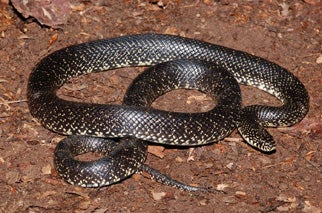SCIENTIFIC NAME:
Lampropeltis nigra
STATUS:
Fairly common above Fall Line Hills in northern Alabama. Formerly considered as L. getula nigra. This non-speckled morph has not declined to extent of Coastal Plain forms L. nigra below the Fall Line. Low Conservation Concern.
DESCRIPTION:
Lampropeltis getula nigra grows to 58 inches in length. It is black with traces of yellow or white spots, or bands above and has a white throat. Their heads are typically small and barely distinct from the neck, the bodies are cylindrical, the scales smooth, and they have a single anal scale. They are strikingly colored.
DISTRIBUTION:
Black kingsnakes inhabit areas from southern Ohio, western West Virginia, southeastern Illinois and south to northeastern Mississippi, north Alabama, and northwestern Georgia.
HABITAT:
They thrive in many habitats including hardwood and pine forests, bottomlands and swamps, farmlands and suburban areas. It is strongly terrestrial, but inhabits areas close to water such as stream banks and swamp boarders. They are secret and are frequently found under boards, tin or other cover objects.
FEEDING HABITS:
Black kingsnakes are active almost exclusively by day, but are most active in the morning during the summer. They are strong constrictors and consume a variety of prey including snakes, lizards, rodents, birds, and turtle eggs. Kingsnakes are resistant to the venom of pit-vipors and they readily eat copperheads, cottonmouths, and rattlesnakes.
LIFE HISTORY AND ECOLOGY:
The black kingsnake, like all kingsnakes, will frequently rattle their tail, release musk, and bite upon capture. They typically tame quick and are often kept as pets. This species mates in the spring and the female will lay three to 24 eggs under debris or in a rotting log in early summer. The eggs hatch in August or September.
Some herpetologists are concerned that the eastern kingsnake is declining in some areas of the Coastal Plain and in Florida. They have nearly disappeared in several areas of their range while remaining quite common in other regions. The exact cause of decline is unknown, but habitat loss and degradation, imported fireants, or disease are potential causes.
REFERENCES:
Haneline, P., Fellow, A., and Dept. of Biological Sciences, Uni. Pittsburg. 1981. Harper and Row Complete Field Guide to North American Wildlife-Eastern Edition. Harper and Row, Inc. New York, NY. pp. 367
Virginia Fish and Wildlife Information Service.
Author:
Jeff Makemson, Certified Wildlife Biologist, Alabama Division of Wildlife and Freshwater Fisheries






